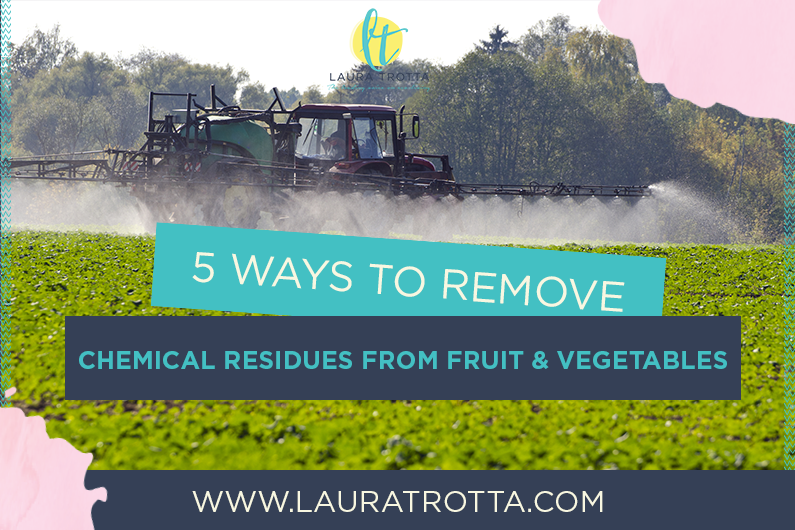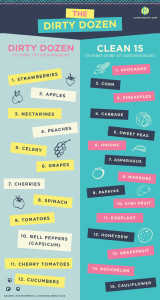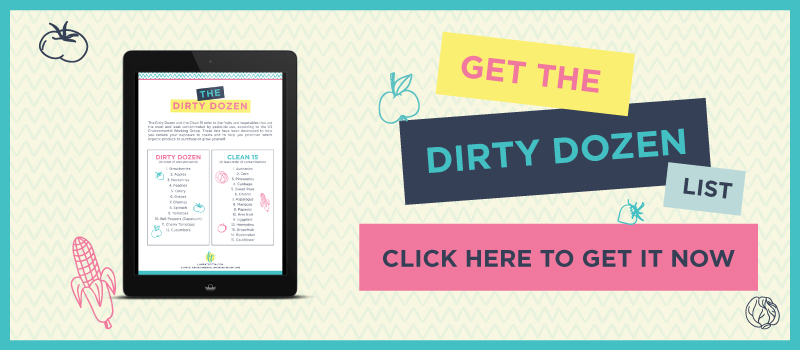In this post I discuss chemical residues in fruit and vegetables and what you can do to reduce your exposure.
When you bite into an apple you think you’re just eating an apple right?
Wrong!
If your apple is a conventionally grown apple it’s most likely come with a side serving of fries, and by fries I mean chemical residues such as pesticides and herbicides.
Podcast: Play In New Window
Why are there chemical residues on fresh fruit and vegetables?
Chemicals such as pesticides, antibiotics and hormones are used in farming to boost production and ensure adequate food for a growing human population.
The use of pesticides can dramatically increase crop production, however pesticides are also toxic chemicals designed to kill agricultural pests, and some can cause problems if they are consumed by humans in large amounts.
Because chemicals are so widespread in conventional farming, it’s no surprise that chemical residues are present in fresh fruit and vegetables.
What types of pesticides are used?
The type of pesticides used largely include insecticides and fungicides, but also include herbicides and synergists (which are chemicals which block the ability of the target organism to break down the pesticide).
The amount of pesticide residue in fruit and vegetables depends on many factors including:
- the type and amount of pesticide used
- the amount of rain, wind and sunshine that fell on the crop
- the type of processing that food undergoes, such as storage time, washing or peeling.
For most pesticides, a minimum time between spraying and harvesting of produce is set to ensure safe food.
While maximum limits for safe human consumption of pesticide residue include wide safety margins, past experience has shown that, sometimes, a pesticide that is thought to be safe for human consumption has been proven otherwise.
DDT (dichlorodiphenyltrichloroethane) is the most obvious example here. DDT was widely used from the late 1940s as an agricultural insecticide. It’s an extremely persistent organic pollutant that accumulates up the food chain, with disastrous effects. Depending on conditions, its soil half life can range from 22 days to 30 years!
It was the impact of DDT on bird populations in particular that led Rachel Carsen to write “A Silent Spring” – the book credited with starting the environmental movement and shining a spotlight on the widespread use of DDT.
DDT is now a recognised endocrine disruptor and is considered likely to be a human carcinogen.
Despite being banned in the United States from 1972 and in Australia from 1987, DDT can still be found in fat deposits of humans around the globe!
How To Remove Chemical Residues From Fresh Produce
So now that you’re well aware that fruit and veggies produced commercially may still contain pesticide residues when you purchase them, you may be keen to know how you can best reduce the amount of chemical residues you consume.
Here’s five ways to reduce chemical toxins in fresh fruit and vegetable produce:
1. Salt Wash
According to the Centre for Science and the Environment, washing fruits and vegetables with 2% of salt water will remove most of the contact pesticide residues normally found on the surfaces of vegetables and fruits.
2. Vinegar soak in sink
While it’s been reported that in some cases, washing fresh produce in water alone can remove up to 80% of pesticide residue, this percentage can increase again by a vinegar soak.
Soak your fruit and vegetables in a solution of 10% white vinegar and 90% water for 15 to 20 minutes and then rinse thoroughly in fresh water.
3. Veggie and Fruit Scrub Cloth
An alternative to soaking your fresh produce is to use a veggie and fruit scrub cloth to physically remove dirt, pesticides, bacteria and wax coatings. Cloths such as the two-sided Norwex Veggie and Fruit Scrub Cloth use water and microfibre technology to remove chemical residues from the surface of produce.
4. Peel fruit and vegetables
Peeling fruit and vegetables is an efficient way to remove residues from the surface, however this technique is obviously not applicable for produce that’s not typically peeled before consumption such as spinach, eggplants and capsicum.
5. Eat organic!
Of course the best way to reduce your consumption of pesticide residues in fruit and vegetables is to buy organic varieties that are grown without chemicals or to grow your own!
Sadly, organic produce is generally more expensive than conventional produce and this is a very real barrier preventing more people from purchasing organic.
Thankfully the Environmental Working Group (EWG) in the USA has produced two lists that help consumers prioritize which fruit and vegetables to buy organic.
Called the Dirty Dozen and Clean 15, these lists were originally compiled from data from the US Department of Agriculture and the US Food and Drug Administration from 2013, covering 34,000 produce samples, and have recently been updated for 2016.
(Note: studies conducted by other developed countries who use similar agricultural practices have yielded similar results.)
When purchasing fruit and vegetables, aim to purchase organic for the varieties on the Dirty Dozen list, as these are typically the most contaminated by chemical residues.
Should you avoid the Dirty Dozen?
The Dirty Dozen list does not imply you should avoid these fruit and vegetables, just that you should prioritize eating organic for these varieties. Avoiding them entirely isn’t the answer as a healthy diet relies on the consumption of a variety of fresh produce.
Wholefoods, including fresh fruit and vegetables, are always a better choice than processed foods.
Committing to cooking whole foods from scratch — together with meal planning, home gardening and food preservation — can largely offset the cost of organic food purchases.
Indeed these principals are core components in my new program that I’ve been creating to release mid 2016……Self Sufficiency in the Suburbs…… and I’ll be telling you more about this exciting project very soon!
In the meantime, head to dirtydozen.lauratrotta.com to download your FREE ‘Dirty Dozen’ Fridge Memo and keep on doing your best to make green mainstream.
Podcast: Play in new window | Download
- Sustainable Home Design- factors to consider to maximise sustainability - July 28, 2022
- Advantage and Disadvantages of Tiny Houses - May 31, 2022
- How School Strike 4 Climate is Empowering Youth to Fight for Their Future - May 1, 2022




 Laura Trotta is one of Australia’s leading home sustainability experts. She has a Bachelor of Environmental Engineering, a Masters of Science (in Environmental Chemistry) and spent 11 years working as an environmental professional before creating her first online eco business, Sustainababy, in 2009. She has won numerous regional and national awards for her fresh and inspiring take on living an ‘ecoceptional’ life (including most recently winning the Brand South Australia Flinders University Education Award (2015) for the north-west region in SA and silver in the Eco-friendly category of the 2015 Ausmumpreneur Awards). With a regular segment on ABC Radio and with her work featured in publications like Nurture Parenting and My Child Magazine, Laura is an eco thought leader who’s not afraid to challenge the status quo. A passionate believer in addressing the small things to achieve big change, and protecting the planet in practical ways, Laura lives with her husband and two sons in outback South Australia.
Laura Trotta is one of Australia’s leading home sustainability experts. She has a Bachelor of Environmental Engineering, a Masters of Science (in Environmental Chemistry) and spent 11 years working as an environmental professional before creating her first online eco business, Sustainababy, in 2009. She has won numerous regional and national awards for her fresh and inspiring take on living an ‘ecoceptional’ life (including most recently winning the Brand South Australia Flinders University Education Award (2015) for the north-west region in SA and silver in the Eco-friendly category of the 2015 Ausmumpreneur Awards). With a regular segment on ABC Radio and with her work featured in publications like Nurture Parenting and My Child Magazine, Laura is an eco thought leader who’s not afraid to challenge the status quo. A passionate believer in addressing the small things to achieve big change, and protecting the planet in practical ways, Laura lives with her husband and two sons in outback South Australia. 


